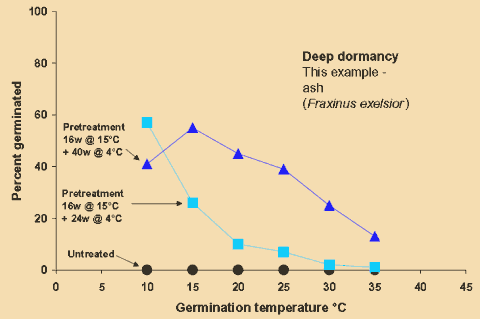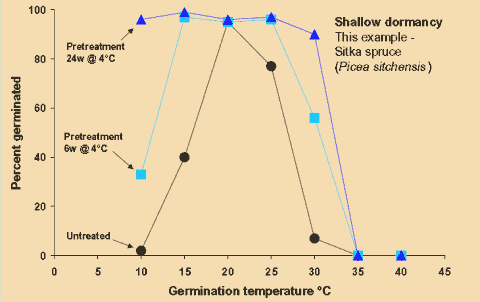A dormant seed is one which is alive, but does not germinate when provided with ample water, good aeration and a suitable temperature (i.e. the normal requirements for plant growth).
Virtually all tree seeds are dormant:
The three figures below demonstrate the characteristics of two sorts of temperate tree seed dormancy and also tropical tree seeds with so called hard-seededness.

Some seeds exhibit ‘deep dormancy’ – the embryo tissues absorb water, begin to metabolise and respire, but remain outwardly inactive at all temperatures.
These seeds appear to have a complete metabolic block (or blocks) to cell elongation, growth, development and differentiation under all conditions.
See graph to observe:
Examples: Most temperate broadleaved species plus Juniperus spp. and Taxus spp.

Some seeds exhibit ‘shallow dormancy’ – the embryo tissues absorb water, begin to metabolise and respire, but remain outwardly inactive at most temperatures.
Shallowly dormant seeds also have a complete metabolic block (or blocks) to cell elongation, growth, development and differentiation – but only under some conditions.
See graph to observe:
Examples: Most temperate conifer species plus Alnus spp. and Betula spp.

Some seeds exhibit ‘hard-seededness’ – often the result of an impermeable seed coat acting as a barrier to water uptake so that the embryo tissues cannot hydrate.
See graph to observe:
Examples: Most temperate and tropical legume tree species.
1 Scarification – any ‘pretreatment’ that removes, abrades, splits, burns or softens the hard seed-coat – without significantly damaging the embryo within; e.g., chipping, filing, boiling / hot water. These are the ONLY tree seeds which do not need to be moist to respond to pretreatment.